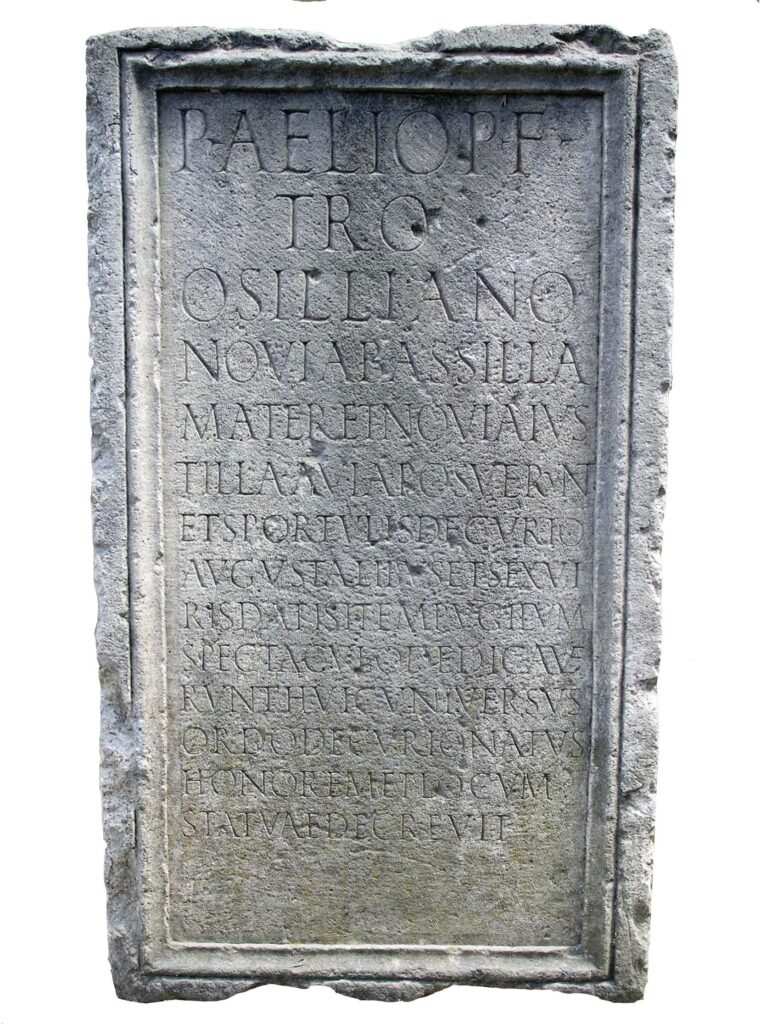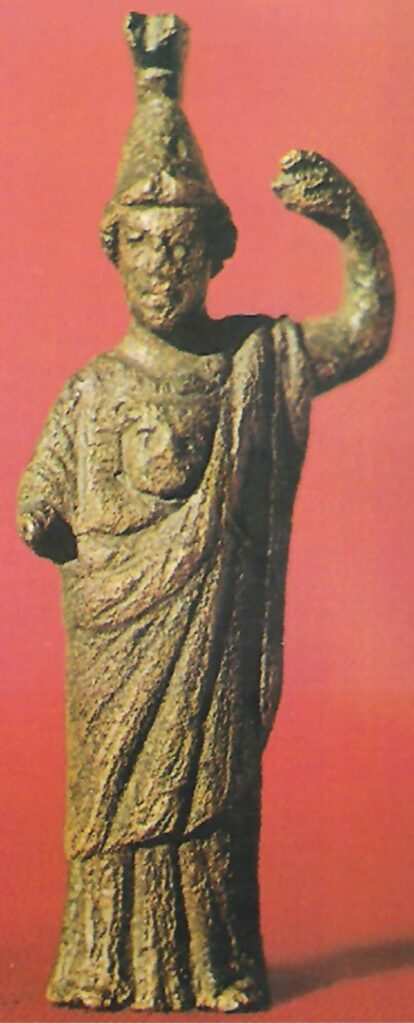The everyday life of people in ancient times was primarily imbued with a sense of respect for the natural forces that rule the world. This notion, called religio, differs from today’s concept of religion. This vague sense of the presence of supernatural danger, akin to superstitious intuition, postponed all tasks unless they could be carried out under favourable auspices, i.e. the signs of the divine approval. The common man treated these forces with extreme humility and tried to please them with prayers, as well as by offering suitable sacrifices, usually in food and drink.
It was believed that two Lares, the guardian deities serving as the protectors of the hearth, were always circling around each house. Their dance repelled evil demons and ensured the well-being of the households. Each household, as well as every settlement, had its own genius (a guardian demon). The genii and the Lares were religious concepts of divine presence in living beings and locations; as such, they received sacrifices on household altars. In fact, one small altar made of stone was uncovered during the renovation works of the Bukovac House.
The Roman religion, developed from heterogenous elements, was originally understood as the influence of a plethora of impersonal forces. However, under the influence of the Greek pantheon, it became more structured. Despite the lack of material confirmation, it can be assumed that all the gods of the Roman pantheon, as well as the later accepted Oriental mystery cults, were worshiped in Epidaurum during the centuries of Roman domination.
One of the most important cults in the Imperial Era was certainly the cult of Augustus. The emperor ascended to his divine status through apotheosis after his death; a temple was built in his honour and a college of priests in charge of maintaining the cult was formed. Such a college also existed in Epidaurum, as evidenced by an inscription dedicated to Publius Aelius Osilianus.

Baltazar Bogišić Collection
From: Archaeologia Adriatica vol. 3, br. 1, 2009.
Namely, in the aforementioned inscription, kept today as part of the Baltazar Bogišić Collection, it is stated that a monument to Publius Aelius Osilianus was erected on a count of the public honour bestowed upon him by the decurions. The monument was commissioned by Osilianus’ mother, Novia Basila, and grandmother, Novia Justila, who wished to further acknowledge him as a distinguished member of the community. On that occasion, as the inscription says, they also distributed appropriate gifts, called sportulae, to members of the city council, as well as to Augustales and seviri; moreover, the two women organized fist-fighting matches for the entertainment of the common people. So, this monument tells us that in Epidaurum there was an organized college of Augustals and seviri – the priests dedicated to the promotion of the imperial cult, the offering of sacrifices to various deities and the organization of various public events.
Another inscription, which has unfortunately been lost, was uncovered in 1911 by the Reverend Father Niko Štuk near the former St. Roch Church – now the Račić Family Mausoleum – perhaps reveals the position of a temple that could have possibly been dedicated to the deities of the Capitoline Triad, i.e. to the supreme god Jupiter and the goddesses Juno and Minerva. Štuk described the circumstances of the inscription’s discovery: `On 11th September 1911, the Epidaurum Antiquarian Society in Cavtat organized an excavation on the hill near the St Roch Chapel, north of the town. The excavation took place on the cadastral unit 143/2, owned by I. Pervitić, where a semicircular brick fence was discerned. There, at a depth of 1.2 metres (4 ft), the remains of an old building with well-preserved concrete made of lime and crushed brick were found. The structure is roughly shaped like a trapezoid, measuring 4.4 metres (≈ 14 ft) on its north side, 7.4 metres (≈ 24 ft) on the east side, 5.4 metres (≈ 17 ft) on the south side, and 5.6 metres (≈ 18 ft) on the west side. Near the bottom of the walls a rimmed lime plaster has been preserved. In the middle of the structure there is a hollow 2.6 metres (≈ 8 ft) long, 1.5 metres (≈ 4 ft) wide and 0.8 metres (≈ 3 ft) deep. This location was reached via steps cut in the cliff, which are still well preserved and are located nearby, on the southwest side of the St Roch Chapel.‘
Štuk subsequently remarked on the discovery of a stone fragment bearing the following initials:
I(ovi) O(ptimo) M(aximo)
V(otum) S(olvit)
It is this votive inscription to Jupiter, containing his epithets optimus maximus (‘the best and greatest’) that alludes to the possible existence of a temple dedicated to the Capitoline Triad at which such an engraving could be found. Sacrifices for the benefit of the emperor and the imperial family were offered to Jupiter since the time of Augustus. Therefore, it is possible that the temple was dedicated to the worship of the imperial cult or, more likely, to Jupiter himself. However, without systematic archaeological research, the object of worship in this temple remains in the realm of speculation.
The lost inscription which was once built into the wall of the St. Mary Church in Mandaljena, serves as another evidence of the spiritual life of our ancestors. The inscription in question worships Diana, the goddess of light and fertility, who is identified with the Greek Artemis. In addition, a statuette of the goddess Minerva has been uncovered in a chance find in Pridvorje. Along with several relief representations of the god Mithras and one Mithraic shrine preserved in situ, all the aforementioned artefacts are the only preserved remains of the Roman cult in this area. Only further archaeological research can provide us with additional knowledge and understanding of the religious practices from that era.


